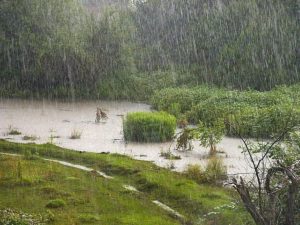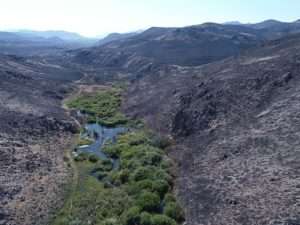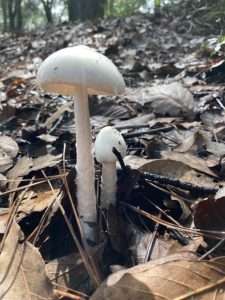Spring foraging season is here, and plenty of us are putting on our hiking boots and grabbing our bags and baskets so we can go out and collect fresh greens, morels, and other good stuff. While it’s a fun and often relaxing activity, foraging is not without its risks. Let’s look at some of the ways you can mitigate those risks and forage safely.
Proper Preparation
 As I tell my foraging students, there are few things less fun than going out foraging on a beautiful, warm day, only to have a storm roll in when you’re a few miles out, the temperature drops twenty degrees, and you’re cold and soaked in a t-shirt because you didn’t bring any layers. Checking the forecast beforehand is a must, and even if there’s no rain on the horizon it’s a good idea to have layers with you anyway, just in case you’re out later than anticipated. You also want to make sure you wear proper footwear; flip-flops might be okay if you’re walking down a sidewalk looking for edible weeds, but in many places you’re going to want something more substantial. I’ve gotten away with tennis shoes in some places that weren’t too rocky or wet, but I have a good pair of hiking boots for more rugged terrain, especially if I think I may be doing some off-trail foraging.
As I tell my foraging students, there are few things less fun than going out foraging on a beautiful, warm day, only to have a storm roll in when you’re a few miles out, the temperature drops twenty degrees, and you’re cold and soaked in a t-shirt because you didn’t bring any layers. Checking the forecast beforehand is a must, and even if there’s no rain on the horizon it’s a good idea to have layers with you anyway, just in case you’re out later than anticipated. You also want to make sure you wear proper footwear; flip-flops might be okay if you’re walking down a sidewalk looking for edible weeds, but in many places you’re going to want something more substantial. I’ve gotten away with tennis shoes in some places that weren’t too rocky or wet, but I have a good pair of hiking boots for more rugged terrain, especially if I think I may be doing some off-trail foraging.
It’s also not a bad idea to have the Ten Essentials in your backpack, even if you’re going on a well-used trail that you’re very familiar with. Emergencies can occur anywhere; back when the Eagle Creek fire ignited in 2017, over 150 people were stranded several miles from the trailhead and had to spend the night in the woods, some only wearing swimsuits. While it had been a hot summer day, the temperatures still dropped considerably overnight. Those folks had only intended to spend a few hours on a popular trail with a swimming hole, and so few were prepared for the fire that trapped them for hours.
Speaking of the Ten Essentials, if you’re planning to do any off-trail foraging, don’t just rely on your GPS, as even these finely-tuned electronics can fail–or run out of battery. Have a map and a compass, and know how to use them.
Finally, make sure someone knows where you’re going, especially if you’re foraging solo. Yes, it may mean you have to tell someone else your super-secret morel-hunting spot, but better that than getting lost and no one knowing where to send search and rescue to look for you.
Sizing Up Your Foraging Site
Once you arrive at your chosen foraging location, you want to do a quick environmental assessment. Double-check the weather, and notice if there are any signs of incoming precipitation. Note also how many hours you have before sundown; you might set an alarm at the halfway point so that you can turn around and still make it back with some daylight. Remember that the light fades faster in valleys and heavily forested areas, so you may need to turn around a little sooner there.
 Pay attention to the condition of the land, and any hazards that are there. For example, this time of year many people are flocking to areas that have burned in the past year or two to look for flushes of morels. Many of these burned areas are off-limits to the public due to hazards, though some are open. In addition to debris left over from the fire, landslides caused by increased erosion are also a possible hazard. Morever, any trails and trail markers may have been destroyed in the fire, making navigation more challenging. And any wilderness area has the usual suite of risks like tripping and falling hazards; any place with a significant river or stream also presents the danger of drowning, especially if you try to cross. Spring is especially risky due to increased precipitation causing higher water levels, along with additional water volume due to spring snow melt.
Pay attention to the condition of the land, and any hazards that are there. For example, this time of year many people are flocking to areas that have burned in the past year or two to look for flushes of morels. Many of these burned areas are off-limits to the public due to hazards, though some are open. In addition to debris left over from the fire, landslides caused by increased erosion are also a possible hazard. Morever, any trails and trail markers may have been destroyed in the fire, making navigation more challenging. And any wilderness area has the usual suite of risks like tripping and falling hazards; any place with a significant river or stream also presents the danger of drowning, especially if you try to cross. Spring is especially risky due to increased precipitation causing higher water levels, along with additional water volume due to spring snow melt.
When foraging in an urban area you’ll want to be mindful of the soil where you are. If the place you’re at has an industrial history, there’s a good chance the soil may be contaminated. Plants and fungi may absorb some of these toxins, and could pass them on to you in whatever parts of them you consume. The same goes for soil near busy roads, where runoff can include oil and other chemicals from vehicles and the asphalt of the road itself, as well as particles from exhaust fumes. I would recommend staying at least 40-50 feet away from busy roads when foraging.
It’s also a good idea to exercise your situational awareness during urban foraging. Make sure you aren’t walking into the path of an oncoming vehicle, not just in the road but in driveways as well. Even if you feel pretty safe on the sidewalk, don’t get so absorbed in foraging that you miss someone walking or biking in your direction. And even urban areas can have uneven terrain like large sidewalk cracks or curbs that can lead to a sprained ankle or nasty fall.
Verifying Your Identifications

The thing that I emphasize to all my foraging students, again and again, in every class, is that you need to be 120% sure that you know exactly what plant or mushroom you have, and that you can absolutely verify that it is edible, before you eat it. I sound like a broken record, but it is exceedingly important. Too many poisonings happen due to mistaken identities, whether that’s someone thinking that the poison hemlock they found is a wild carrot, or someone picking a young destroying angel mushroom because it looks superficially like a puffball.
I am a very, very cautious forager. Even though I have been foraging for many years, and have taught many students, I still err strongly on the side of caution. When I have foraged a plant or mushroom that’s new to me, I always check multiple sources–field guides, websites and blogs, other foragers, etc.–to not only make sure that I have positively identified what I’ve found, but to also make sure it’s definitely edible. Even if I know the species I’ve found, if I haven’t eaten it before I do my due diligence to make sure it’s still considered edible. For example, the angel wing mushroom (Pleurocybella porrigens) has long been considered an edible species. However, in 2004 almost five dozen people fell ill from eating these mushrooms, and seventeen of them died. While the victims all had compromised kidneys in common, it still raises the concern as to whether angel wings should still be considered safely edible or not. My general rule is that if there’s any disagreement over a particular species’ edibility, I won’t eat it; there are plenty of other good things to eat that I know won’t hurt me.
This also illustrates why it’s so important to accurately identify what you’ve foraged, and why my classes are so focused on identification skills and tools. Sure, some inedible or toxic plants and mushrooms may only give you a day or two of nasty gastrointestinal distress, and then you’ll be okay. But some can legitimately kill you, even in small quantities; half the cap of a destroying angel mushroom (Amanita ocreata or Amanita bisporigera) can be lethal.
Forage Safely, Forage Well, Forage Long
I don’t want to scare novices away from getting out and looking for wild edible plants and mushrooms. With a little care and foresight, you can keep your foraging fun! Just remember that no matter how experienced you become, it’s important to never let your guard down. As the saying goes, there are old mushroom hunters and there are bold mushroom hunters, but there are no old, bold mushroom hunters. I for one would prefer to grow up to be an old mushroom (and plant) hunter, even if it means taking things a little more slowly and cautiously.

My land has lots of flixweed growing on it. I was wondering if you knew how to properly harvest the leaves, stems, roots, and seeds. The other articles I’ve seen online say you can harvest, but they don’t give good directions. I want to be cautious and learn from foraging experts since I am new, but I don’t know any teachers in my area.
Hi there! Unfortunately I don’t have experience with flixweed since it doesn’t grow in the area I’m in. I would contact the authors/sites that have the articles you’ve seen about it so far and ask them for details.